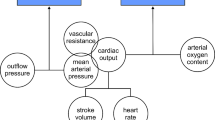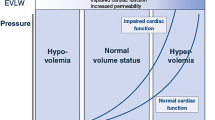Abstract
The influence of severe thermal injury (full-thickness burns involving 50% of the body surface area) on hepatic blood flow in the rat was assessed using the tricarbocyanine dye indocyanine green (ICG). In a randomized crossover fashion, rats received sequential infusions of ICG through both the femoral vein and the portal vein, allowing the estimation of total hepatic plasma clearance and trans-hepatic extraction of the dye. These two parameters, along with the hematocrit, were used to calculate intrinsic hepatic clearance of ICG and hepatic blood flow. Animals were examined at 0 (control), 0.5, 12, or 24 hr following infliction of scald burns. Hepatic blood flow was decreased significantly by 0.5 hr postburn and remained approximately 20% below normal throughout the remainder of the study. The intrinsic efficiency of the liver in removing ICG from the systemic circulation was also decreased by thermal injury. The potential mechanisms involved in these two physiologic perturbations are discussed.
Similar content being viewed by others
REFERENCES
J. A. J. Martyn, D. J. Greenblatt, and W. C. Quinby. Diazepam kinetics in patients with severe burns. Anesth. Anaig. 62:293–297 (1983).
J. A. J. Martyn and D. J. Greenblatt. Lorazepam conjugation is unimpaired in burn trauma. Clin. Pharmacol. Ther. 43:250–255 (1988).
L. Durlofsky and R. J. Fruncillo. Impaired drug-metabolizing ability in the burned rat. J. Trauma 22:950–953 (1982).
R. J. Fruncillo and G. J. DiGregorio. The effect of thermal injury on drug metabolism in the rat. J. Trauma 23:523–529 (1983).
R. J. Fruncillo and G. J. DiGregorio. Pharmacokinetics of pentobarbital, quinidine, lidocaine, and theophylline in the thermally injured rat. J. Pharm. Sci. 73:1117–1121 (1984).
K. S. Pang and M. Rowland. Hepatic clearance of drugs. I. Theoretical considerations of a “well-stirred” model and a “parallel tube” model. Influence of hepatic blood flow, plasma and blood cell binding, and the hepatocellular enzymatic activity on hepatic drug clearance. J. Pharmacokinet. Biopharm. 5:625–653 (1977).
K. L. R. Brouwer and M. Vore. Effect of hypoxia and pregnancy on antipyrine metabolism in isolated perfused rat livers. J. Pharmacol. Exp. Ther. 234:584–589 (1985).
E. L. Dobson and G. F. Warner. Factors concerned in the early stages of thermal shock. Circ. Res. 5:69–74 (1957).
D. Loew and K. Meng. Acute renal failure in experimental shock due to scalding. Kidney Int. 10:S81–S85 (1976).
R. G. Abell and I. H. Page. A study of the smaller blood vessels in burned dogs and cats. Surg. Gynecol. Obstet. 77:348–353 (1943).
J. L. Ferguson, I. Hikawyj-Yevich, and H. I. Miller. Body fluid compartment changes during burn shock in the guinea pig. Circ. Shock 7:457–466 (1980).
J. L. Ferguson, G. F. Merrill, H. I. Miller, and J. J. Spitzer. Regional blood flow redistribution during early burn shock in the guinea pig. Circ. Shock 4:317–326 (1977).
B. E. Schildt. Liver blood flow in traumatized mice. Acta Chir. Scand. 138:59–68 (1972).
S. Wetterlin and I. Bjorkman. Cardiac output and regional blood flow in untreated and vasopressin-treated burned mice. Scand. J. Plast. Reconstr. Surg. 11:109–113 (1977).
L. H. Aulick, C. W. Goodwin, R. A. Becker, and D. W. Wilmore. Visceral blood flow following thermal injury. Ann. Surg. 193:112–116 (1981).
D. W. Wilmore, C. W. Goodwin, L. H. Aulick, M. C. Powanda, A. D. Mason, and B. A. Pruitt. Effect of injury and infection on visceral metabolism and circulation. Ann. Surg. 192:491–504 (1980).
C. M. Leevy, C. L. Mendenhall, W. Lesko, and M. M. Howard. Estimation of hepatic blood flow with indocyanine green. J. Clin. Invest. 41:1169–1179 (1962).
H. L. Walker and A. D. Mason. A standard animal burn. J. Trauma 8:1049–1051 (1968).
G. Arturson. Pathophysiologic aspects of the burn syndrome. Acta Chir. Scand. (Suppl.) 274:1–135 (1961).
C. Teplitz. The pathophysiology of burns and the fundamentals of burn wound sepsis. In C. P. Artz, J. A. Moncrief, and B. A. Pruitt (eds.), Burns: A Team Approach, Saunders, Philadelphia, 1979.
G. M. Pollack, K. L. R. Brouwer, K. B. Demby, and J. A. Jones. Determination of hepatic blood flow in the rat using sequential infusions of indocyanine green or galactose. Drug Metab. Dispos. 18:197–202 (1990).
M. Gibaldi and D. Perrier. Pharmacokinetics, Marcel Dekker, New York, 1982.
C. D. Klaassen and G. L. Plaa. Plasma disappearance and biliary excretion of indocyanine green in rats, rabbits, and dogs. Toxicol. Appl. Pharmacol. 15:374–384 (1969).
T. K. Daneshmend, L. Jackson, and C. J. C. Roberts. Physiological and pharmacological variability in estimated hepatic blood flow in man. Br. J. Clin. Pharmacol. 11:491–496 (1981).
B. W. Brown and M. Hollander. Statistics: A Biomedical Introduction, John Wiley and Sons, New York, 1977.
M. B. Dorr, S. J. Weigel, and G. M. Pollack. Alterations in hepatic blood flow following thermal injury in the rat. Abstr. APhA Acad. Pharm. Sci. 15:147 (1985).
A. J. Czaja, T. A. Rizzo, W. R. Smith, and B. A. Pruitt. Acute liver disease after cutaneous thermal injury. J. Trauma 15:887–894 (1975).
B. A. Pruitt, A. D. Mason, and J. A. Moncrief. Hemodynamic changes in the early postburn patient. J. Trauma 11:36–46 (1971).
G. Paumgartner, P. Probst, R. Kraines, and C. M. Leevy. Kinetics of indocyanine green removal from the blood. Ann. N. Y. Acad. Sci. 170:134–147 (1970).
J. W. L. Davies. Physiological Responses to Burning Injury, Academic Press, London, 1982.
G. Birke, L. A. Carlson, and U. S. von Euler. Studies on burns. XII. Lipid metabolism, catecholamine excretion, basal metabolic rate and water loss during treatment of burns with warm dry air. Acta Chir. Scand. 138:321–333 (1972).
S. M. Talaat, G. E. Beheri, and M. S. Zaki. Prevention of early histopathological changes in the liver in extensive burns. Br. J. Plast. Surg. 26:132–139 (1973).
C. Yi-Sheng, L. Ngao, S. Jing-Quan, L. Yuan-ping, and J. W. L. Davies. Histopathological and ultrastructural changes in liver tissue from burned patients. Burns 11:408–418 (1985).
C. D. Klaassen and J. B. Watkins. Mechanisms of bile formation, hepatic uptake, and biliary excretion. Pharmacol. Rev. 36:1–67 (1984).
K. J. Baker. Binding of sulfobromophthalein (BSP) and indocyanine green (ICG) to plasma α1 lipoproteins. Proc. Soc. Exp. Biol. Med. 122:957–963 (1966).
J. C. Daniels, D. L. Larson, S. Abston, and S. E. Ritzman. Serum protein profiles in thermal burns. I. Serum electrophoretic patterns, immunoglobulins, and transport proteins. J. Trauma 14:137–152 (1974).
M. Miskulin, F. Moat, A. M. Robert, R. R. Monteil, and G. Guilbaud. Serum proteins in heavily burnt patients. J. Med. 9:405–422 (1978).
Author information
Authors and Affiliations
Rights and permissions
About this article
Cite this article
Pollack, G.M., Brouwer, K.L.R. Thermal Injury Decreases Hepatic Blood Flow and the Intrinsic Clearance of Indocyanine Green in the Rat. Pharm Res 8, 106–111 (1991). https://doi.org/10.1023/A:1015898827312
Issue Date:
DOI: https://doi.org/10.1023/A:1015898827312




